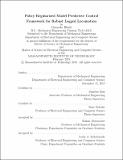| dc.contributor.advisor | Sangbae Kim and Russ Tedrake. | en_US |
| dc.contributor.author | Bledt, Gerardo | en_US |
| dc.contributor.other | Massachusetts Institute of Technology. Department of Electrical Engineering and Computer Science. | en_US |
| dc.date.accessioned | 2018-05-23T15:03:48Z | |
| dc.date.available | 2018-05-23T15:03:48Z | |
| dc.date.copyright | 2018 | en_US |
| dc.date.issued | 2018 | en_US |
| dc.identifier.uri | http://hdl.handle.net/1721.1/115593 | |
| dc.description | Thesis: S.M., Massachusetts Institute of Technology, Department of Mechanical Engineering, 2018. | en_US |
| dc.description | Thesis: S.M., Massachusetts Institute of Technology, Department of Electrical Engineering and Computer Science, 2018. | en_US |
| dc.description | This electronic version was submitted by the student author. The certified thesis is available in the Institute Archives and Special Collections. | en_US |
| dc.description | Cataloged from student-submitted PDF version of thesis. | en_US |
| dc.description | Includes bibliographical references (pages 67-71). | en_US |
| dc.description.abstract | A novel Policy Regularized Model Predictive Control (PR-MPC) framework is developed to allow general robust legged locomotion with the MIT Cheetah quadruped robot. The full system is approximated by a simple control model that retains the key nonlinearities characteristic to legged contact dynamics while reducing the complexity of the continuous dynamics. Nominal footstep locations and feedforward forces for controlling the robot's center of mass are designed from simple physics-based heuristics for steady state legged movement. By regularizing the predictive optimization with these policies, we can exploit the known dynamics of the system to bias the controller towards the steady state gait while remaining free to explore the cost space during transient behaviors and disturbances. The nonlinear optimization makes use of direct collocation on the simplified dynamics to pose the problem with a highly sparse structure for fast computation. A generalized approach to the controller design is independent from specific gait pattern and reference policy and allows stabilization of aperiodic locomotion. Simulation results show dynamic capabilities in a variety of gaits including trotting, bounding, and galloping, all without changing the set of algorithm parameters between experiments. Robustness to sensor and input noise, large push disturbances, and unstructured terrain demonstrate the ability of the predictive controller to adapt to uncertainty. | en_US |
| dc.description.statementofresponsibility | by Gerardo Bledt. | en_US |
| dc.format.extent | 71 pages | en_US |
| dc.language.iso | eng | en_US |
| dc.publisher | Massachusetts Institute of Technology | en_US |
| dc.rights | MIT theses are protected by copyright. They may be viewed, downloaded, or printed from this source but further reproduction or distribution in any format is prohibited without written permission. | en_US |
| dc.rights.uri | http://dspace.mit.edu/handle/1721.1/7582 | en_US |
| dc.subject | Mechanical Engineering. | en_US |
| dc.subject | Electrical Engineering and Computer Science. | en_US |
| dc.title | Policy regularized model predictive control framework for robust legged locomotion | en_US |
| dc.type | Thesis | en_US |
| dc.description.degree | S.M. | en_US |
| dc.contributor.department | Massachusetts Institute of Technology. Department of Electrical Engineering and Computer Science | |
| dc.contributor.department | Massachusetts Institute of Technology. Department of Mechanical Engineering | |
| dc.identifier.oclc | 1036985468 | en_US |
